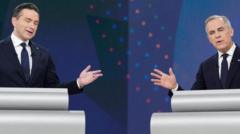The leaders of Canada’s primary political parties delivered an electrifying performance in their second and concluding debate ahead of the general elections scheduled for this month. In an unusual twist, the shadow of U.S. President Donald Trump loomed large over the proceedings, highlighting the reciprocal influences of Canadian and American politics.
As Liberal leader Mark Carney, a former governor of the Bank of England and the frontrunner in current polls, faced off against Conservative leader Pierre Poilievre, New Democratic Party leader Jagmeet Singh, and Bloc Québécois leader Yves-François Blanchet, it became apparent that the ongoing trade tensions with the U.S. would take center stage.
One significant focal point emerged as Carney confronted his opponents' assertions linking him to the record of his unpopular predecessor, former Prime Minister Justin Trudeau. Poilievre made pointed references to the "lost Liberal decade," while Blanchet pressed Carney, challenging him to substantiate his claims of being fundamentally different from Trudeau. In response, Carney insisted on his distinctiveness, arguing that he had only recently taken up the role.
The debate saw discussions on the effective handling of Trump's tariffs, which have previously affected trade dynamics between Canada and the U.S. While Canada’s government has considered a "dollar-for-dollar" tariff system, Carney suggested a more strategic approach, highlighting the challenges posed by the sheer size and power of the U.S. economy.
Apart from international trade, the four leaders also offered their perspectives on pressing domestic issues, such as housing, crime, and immigration. Poilievre advocated for a government focused on low taxes and limited intervention, while Singh proposed enhanced healthcare programs. Carney moderated between these extremes with a centrist view, and Blanchet defended Quebec's unique status within Canada.
As smaller parties sought relevance amidst a landscape dominated by Liberal and Conservative agendas, leaders like Singh actively sought to carve out a niche for the New Democrats. Singh's attempts to engage and interrupt both Carney and Poilievre highlighted his determination to resonate with left-leaning voters. In a similar vein, Blanchet invoked issues specific to Quebec to maintain his party's relevance.
Despite moments of tension and spirited exchanges, there was a notable emphasis on civility throughout the debate, setting a more measured tone compared to recent U.S. political debates. Post-debate interactions between Carney and Poilievre included cordial handshakes and laughter, marking a return to a more civilized electoral discourse.
As Canadians prepare to head to the polls, the clarity of choice among the leading political factions stands juxtaposed against the backdrop of external influences, primarily from the U.S., framing a pivotal moment in Canadian politics.

















